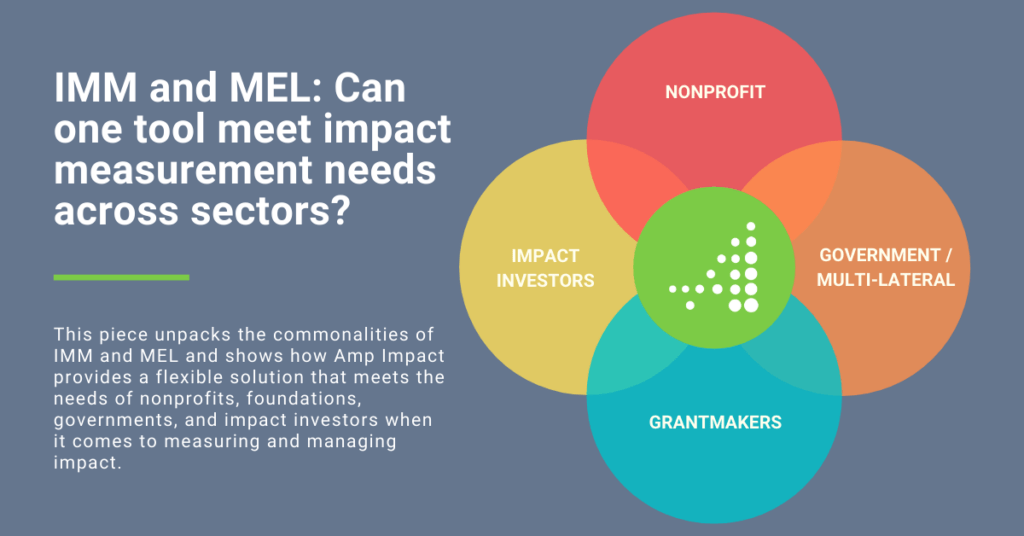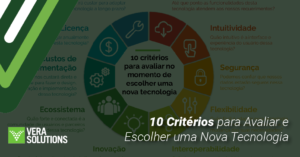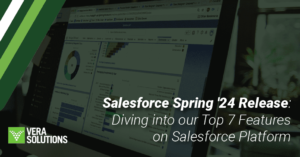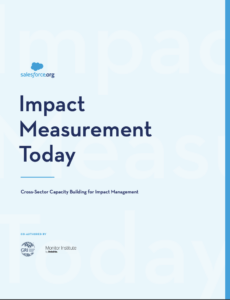
The whitepaper was published in follow-up to an event in December 2019 that convened key leaders and practitioners in IMM. Participants–including nonprofits, foundations, government, private investing, and corporations–identified six core areas and needs for better impact measurement and management across sectors:
- Skills: We need people with the right skills and sufficient time to collect, capture, manage, analyse, and utilise data effectively.
- Awareness: We need to build the case for impact measurement and management.
- Impact Data and Tech Solutions: We need suitable, consistent instruments for improving quantity, quality, and interoperability of data.
- Greater Standardization: We need greater alignment across data standards and comparability.
- Policy: We need policy and regulation to drive greater disclosure and reporting.
- Ethical Use of Data: We need accountability for data usage, considering important topics like privacy, ownership, and others.
Having worked with more than 300 social sector organizations across 60 countries – from large i-NGOs to community based organizations, from funders and impact investors to social enterprises – building their capacity to collect, manage, analyze, and disseminate impact data, we couldn’t agree more with the report’s central assertion “that much is to be gained by looking at cross-sector opportunities to build impact management capacity.”
This shared belief is what propelled us to launch Amp Impact – a Salesforce-based solution for organizations pursuing impact – back in 2017. Leveraging the power and configurability of the Salesforce Platform, Amp Impact extends to a wide range of use cases and is used by nonprofits, foundations, government, and impact investors in more than 50 countries. Some organizations use Amp Impact specifically to advance IMM practices; others use it to integrate IMM into a central tool for managing a portfolio of grants, projects, programs, or investments. Amp Impact provides a unified technology solution to improve the quality and interoperability of data and advance cross-sector IMM efforts.
This shared belief is what propelled us to launch Amp Impact – a Salesforce-based solution for organizations pursuing impact – back in 2017. Leveraging the power and configurability of the Salesforce Platform, Amp Impact extends to a wide range of use cases and is used by nonprofits, foundations, government, and impact investors in more than 50 countries. Some organizations use Amp Impact specifically to advance IMM practices; others use it to integrate IMM into a central tool for managing a portfolio of grants, projects, programs, or investments. Amp Impact provides a unified technology solution to improve the quality and interoperability of data and advance cross-sector IMM efforts.
VIEW WEBINAR: Capacity Building to Scale Your Digital
Transformation Strategy
“Impact Measurement and Management?” … I thought it was called...
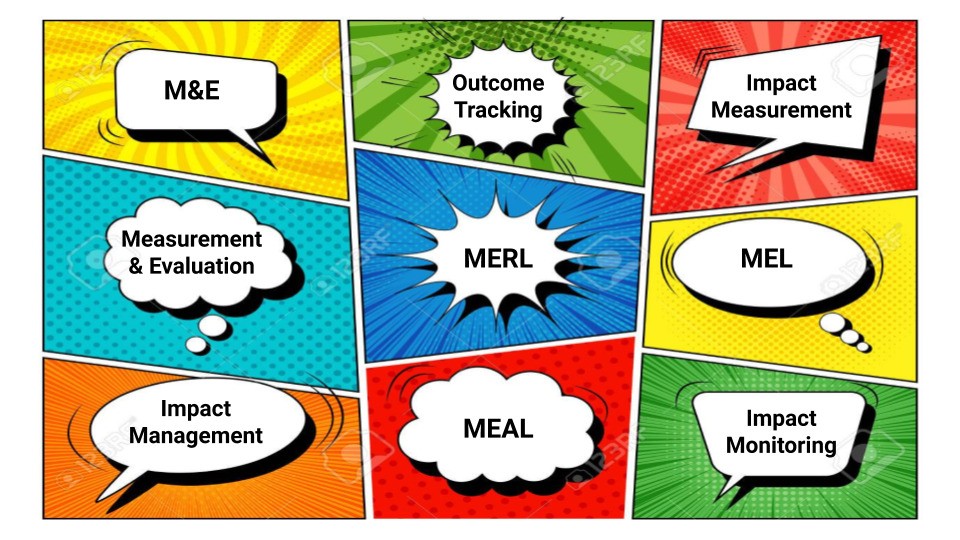
Before getting into how Amp Impact advances IMM efforts, let’s start by defining what IMM is and demystifying how it intersects with other commonly used terms, such as “M&E”, “MERL”, “MEAL”, “MEL”, and so on.
In essence, IMM is a combination of impact measurement – defined as the broad set of processes and activities used to assess the change or progress toward the goal – and impact management, how organizations manage the efforts affecting this change/progress using a collection of competencies, practices, and technologies. That is, in effect, exactly what most organizations mean when they talk about monitoring, evaluation, and learning. So we would say that IMM and MEL are one in the same (and plead with the powers that be to stop introducing new, duplicative acronyms).
IMM and MEL come down to asking and answering questions about a program/intervention. These questions can be about the program’s inputs, activities, and outputs (e.g. Are we doing what we said we’d do? Who participated in the program? How many people have we reached?) or about effectiveness, efficiency, and value (e.g. Did our program lead to the expected change in short- or medium-term outcomes? Was it cost-effective? Who saw the most benefit?)
In sum, impact measurement and management encompasses the strategies, practices, processes, systems, and tools that go into asking and answering questions for continuous improvement and learning.
In essence, IMM is a combination of impact measurement – defined as the broad set of processes and activities used to assess the change or progress toward the goal – and impact management, how organizations manage the efforts affecting this change/progress using a collection of competencies, practices, and technologies. That is, in effect, exactly what most organizations mean when they talk about monitoring, evaluation, and learning. So we would say that IMM and MEL are one in the same (and plead with the powers that be to stop introducing new, duplicative acronyms).
IMM and MEL come down to asking and answering questions about a program/intervention. These questions can be about the program’s inputs, activities, and outputs (e.g. Are we doing what we said we’d do? Who participated in the program? How many people have we reached?) or about effectiveness, efficiency, and value (e.g. Did our program lead to the expected change in short- or medium-term outcomes? Was it cost-effective? Who saw the most benefit?)
In sum, impact measurement and management encompasses the strategies, practices, processes, systems, and tools that go into asking and answering questions for continuous improvement and learning.
READ BLOG: Four Pillars for Monitoring and Evaluating the Social Bottom Line
Advancing cross-sector IMM efforts with Amp Impact
After hundreds of technology implementations for social sector organizations globally, we identified common needs in the way implementers and funders track and manage portfolios, define indicators, and measure impact, and the power of the Salesforce Platform to meet these needs. There was a missing piece, however – a packaged set of functionality and data structures that could solve for the common denominator and align organizations’ approach to managing portfolio-level impact data.



We built Amp Impact as that common denominator solution for nonprofits, grantmakers, governments, impact investors, and accelerators, enabling them to track progress against performance metrics within a portfolio over time and across geographies.
Aligning on taxonomy while flexing on terminology
Over the years, one of the key challenges in achieving true cross-sector solutions has been a perceived misalignment. One of the most important things we’ve come to learn is that there is excellent IMM alignment across sectors in taxonomy, but not as much in terminology (in fact, the different-but-same labels of IMM and MEL are a perfect example of this).
Taxonomy is the classification of things based on a predetermined system. Most experts and practitioners agree on the central taxonomies of IMM or MEL practice. For example, across sectors, impact-driven organizations use a Theory of Change and/or Logic Models to articulate how a program expects to achieve its desired outcomes and impact, describing a problem or an opportunity for change, target outcomes that represent progress towards addressing the problem, and the pathway through which the outcomes are expected to be achieved. Similarly established and agreed-upon taxonomies are crucial when it comes to work planning or financial management.
Amp Impact provides the technology infrastructure for these taxonomies. It has built-in functionality to manage the lifecycle of programs, projects, grants, and investments and map Logframes to understand the relationships between inputs, activities, outputs, outcomes, and impacts/goals, and create work plans to track activities and milestones. You can define indicators and track results against targets to monitor performance over time. You can set up narrative templates for tracking qualitative progress. You can connect any or all of these data with your budgets, expenditure, and disbursements. And we’re just getting started…
Bottom line: the taxonomy of impact data is consistent for nonprofits, grantmakers, and impact investors. Why would we need different tools across different sectors?
Taxonomy is the classification of things based on a predetermined system. Most experts and practitioners agree on the central taxonomies of IMM or MEL practice. For example, across sectors, impact-driven organizations use a Theory of Change and/or Logic Models to articulate how a program expects to achieve its desired outcomes and impact, describing a problem or an opportunity for change, target outcomes that represent progress towards addressing the problem, and the pathway through which the outcomes are expected to be achieved. Similarly established and agreed-upon taxonomies are crucial when it comes to work planning or financial management.
Amp Impact provides the technology infrastructure for these taxonomies. It has built-in functionality to manage the lifecycle of programs, projects, grants, and investments and map Logframes to understand the relationships between inputs, activities, outputs, outcomes, and impacts/goals, and create work plans to track activities and milestones. You can define indicators and track results against targets to monitor performance over time. You can set up narrative templates for tracking qualitative progress. You can connect any or all of these data with your budgets, expenditure, and disbursements. And we’re just getting started…
Bottom line: the taxonomy of impact data is consistent for nonprofits, grantmakers, and impact investors. Why would we need different tools across different sectors?
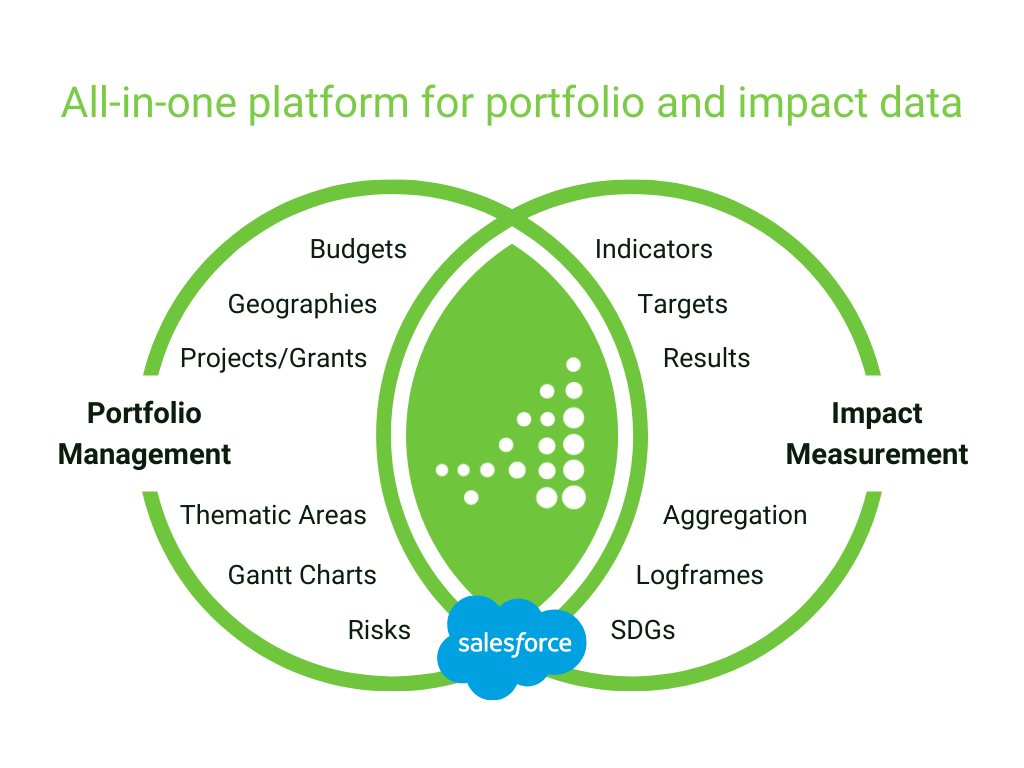
Terminology, on the other hand, is where organizations differ depending on their programs, funders, geographies, and offerings. A humanitarian organization delivers programs or projects while a grantmaker disburses grants. A nonprofit might track key performance indicators while an accelerator measures impact metrics. Luckily, Amp Impact (and the Salesforce Platform in general) is incredibly flexible to align with the terminology that your organization uses while keeping the taxonomy aligned with best practice.
“For over 12 years, we’ve seen data alignment efforts fail because software providers, funders, and implementers waste an unimaginable amount of time debating ‘what should we call this field?’ or get flustered when they realize the same piece of information is called one thing in one geography and another somewhere else,” says Vera CEO Zak Kaufman. “A great thing about Amp Impact being natively built on the Salesforce Platform is that it facilitates alignment of the data taxonomy while allowing adjustment and translation of the terminology to each organization’s context.”
As Salesforce.org, Deloitte, and GRI outline in their white paper, impact measurement and management practices shouldn’t need to differ between nonprofits, foundations, governments, and impact investors. The commonalities outlined in the Impact Measurement Today whitepaper are the same commonalities that we’ve seen over the last decade of serving organizations around the globe – the same commonalities that inspired us to build a cross-sector software product on the Salesforce Platform. A great deal of efficiency can be gained through alignment, and we look forward to a future where nonprofits, social enterprises, funders, governments, and impact investors all speak the same language (or at least share the same impact data structures) so we can collectively progress social, cultural, community, economic, and environmental change.
“For over 12 years, we’ve seen data alignment efforts fail because software providers, funders, and implementers waste an unimaginable amount of time debating ‘what should we call this field?’ or get flustered when they realize the same piece of information is called one thing in one geography and another somewhere else,” says Vera CEO Zak Kaufman. “A great thing about Amp Impact being natively built on the Salesforce Platform is that it facilitates alignment of the data taxonomy while allowing adjustment and translation of the terminology to each organization’s context.”
As Salesforce.org, Deloitte, and GRI outline in their white paper, impact measurement and management practices shouldn’t need to differ between nonprofits, foundations, governments, and impact investors. The commonalities outlined in the Impact Measurement Today whitepaper are the same commonalities that we’ve seen over the last decade of serving organizations around the globe – the same commonalities that inspired us to build a cross-sector software product on the Salesforce Platform. A great deal of efficiency can be gained through alignment, and we look forward to a future where nonprofits, social enterprises, funders, governments, and impact investors all speak the same language (or at least share the same impact data structures) so we can collectively progress social, cultural, community, economic, and environmental change.
We’re curious to hear what challenges you’re facing in measuring and managing your impact. Schedule a chat.

